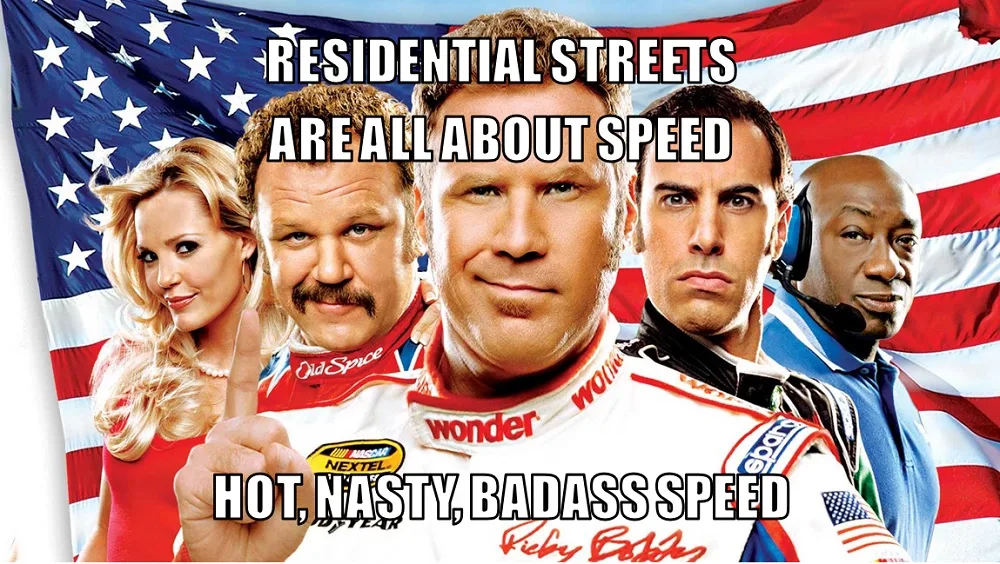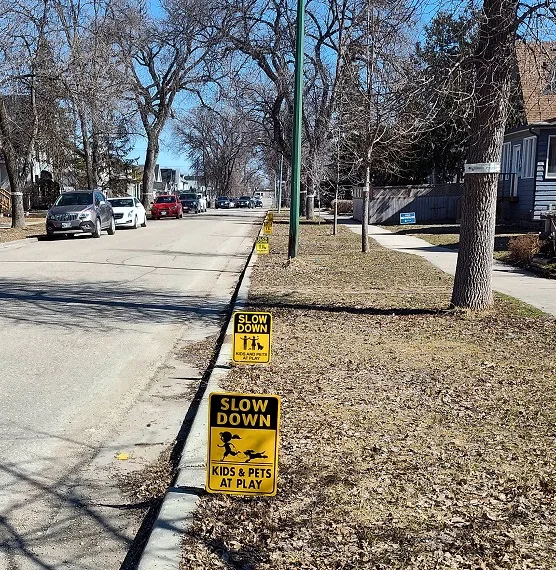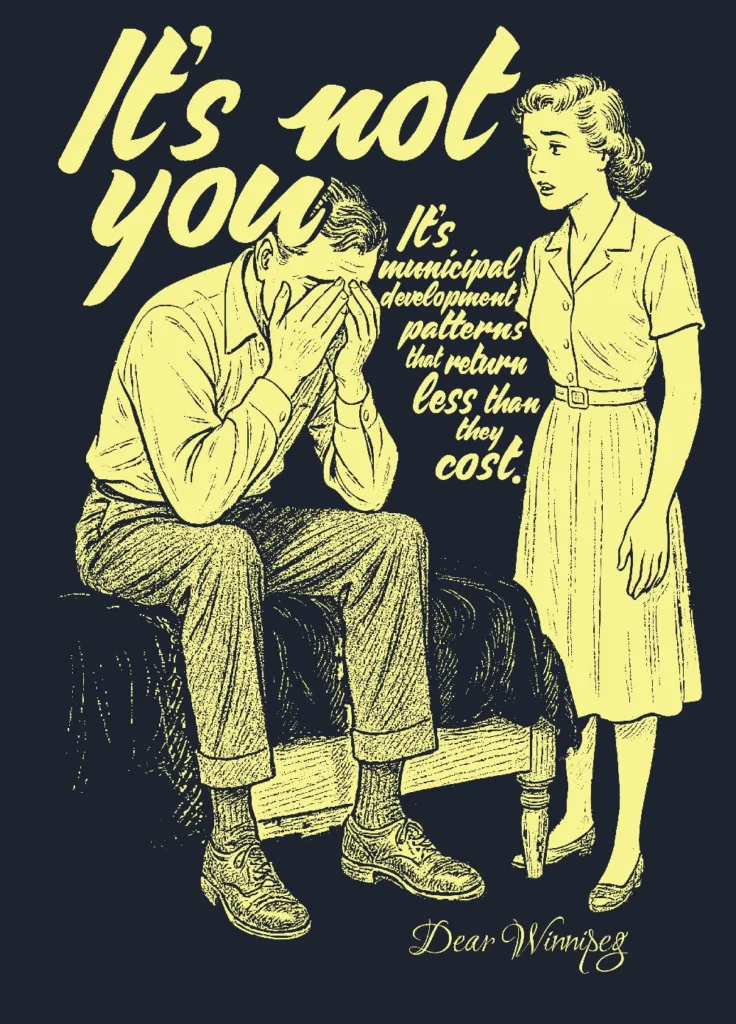
Fact: Cars Are Rarely Speeding in Residential Areas

Dear Winnipeg,
I’m going to cut to the chase. You’re almost certainly wrong if you think cars are speeding down your residential street. There, I said it.
I mean, that’s if “speeding” to you means exceeding the speed limit. Which it probably does.
Oh sure, it does happen in some places. Like on Cambridge St where a traffic study commissioned in February 2024 showed that between 1% and 40% of vehicles exceeded the posted speed limit of 50 km/h, depending on the segment of street.
That’s why last month, more than a year after that study was approved, the City finally approved physical traffic calming measures be installed on and around Cambridge St in order to increase safety in that neighbourhood. This was a big deal, it was in the news and everything!
Now, if fourteen months seems like an unreasonable amount of time to deal with speeding traffic on the street where you live, you should know that the people living there have actually been advocating for slowing traffic in their neighbourhood for more than thirty years.
They even dug up a traffic study from 1994 that proves that this has been a problem in their neighbourhood for a very long time. Yet despite identifying child safety and high vehicle speeds as issues to be addressed, that nearly 150-page study didn’t even measure vehicle speeds. I guess we’ll never know for sure if drivers were consistently driving over the speed limit in the 1990s, but it’s possible they weren’t, and also why the traffic calming measures listed in that report never got installed.
Because engineers tend to apply very strict rules around when traffic calming is “warranted”. Don’t meet the criteria? Sorry bubs, then traffic calming is not “warranted” on your street.
Let me give you an example from my neighbourhood. In June 2004, a full 73% of residents on Hart Ave signed a petition to the City to install speed bumps to slow traffic in front of their homes.
This led to a multi-year traffic study that would examine whether speed bumps were warranted. At the time, you had to meet at least one of these criteria:
- Average Speed exceeds the speed limit; OR
- At least 15% of vehicles exceed the speed limit by 5 km/h or more; OR
- At least 10% of vehicles exceed the speed limit by 10 km/h or more
After measuring traffic speeds for five years, here were the results of the Hart Avenue Traffic Study:
| Location on Hart Ave | Average Weekday Traffic Volume | 85th Percentile Speed | Average Speed | Percent of Vehicles travelling 55 km/h or more (15% minimum) | Percent of Vehicles travelling 60 km/h or more (10% minimum) |
| West of Henderson (2002) | 540 | 47 km/h | 36 km/h | 5% | 3% |
| West of Henderson (2003) | 507 | 45 km/h | 35 km/h | 6% | 3% |
| West of Henderson (2004) | 487 | 49 km/h | 37 km/h | 7.5% | 1% |
| West of Henderson (2005) | 464 | 44 km/h | 33 km/h | 2.5% | 1% |
| West of Henderson (2007) | 491 | 47 km/h | 35 km/h | 4% | 2% |
It turns out only 5% of vehicles were ever “speeding”, ie. exceeding the speed limit by 5 km/h or more. Not only that, but 85% of vehicles were travelling below 44-49 km/h. In fact, the average vehicle travelled between 33-37 km/h.
And yet, 73% of residents here felt so strongly that vehicles were speeding that they organized together to sign a petition to the City to do something about it.
So sorry Hart Ave residents, you’re wrong. No traffic calming for you.
Interestingly, a quick search for “traffic calming” in the City’s records reveals nearly 500 results for traffic study reports that were presented to the Public Works committee in the last ten years alone. Multiply each of those by the petition threshold needed to trigger a study in the first place, and that makes a LOT of people who think traffic is going too fast in their neighbourhoods.
And yet, you’ll struggle to find even a handful of those studies leading to traffic calming measures being implemented. Because the actual data shows that cars are, generally, not actually speeding. Often, they’re even going well below the posted speed limit.
What gives?
Could it be that the speed that feels safe to humans, and the current speed limits in our neighbourhoods are not the same?

How could this be? The current speed limits were set based on rigorous scientific evidence, right?
Right?
RIGHT??
Well, according to Wes Marshall, PhD, a licensed Professional Engineer, a professor of civil engineering at the University of Colorado Denver (where he holds a joint appointment in urban planning), and the author of Killed by a Traffic Engineer: Shattering the Delusion that Science Underlies Our Transportation System, it seems they, uh (checks notes), were not.
If you haven’t read the book, I highly recommend it. But only if you won’t be shocked to learn that the “science” behind setting some of our modern-day speed limits involved asking “a bunch of college kids from UCLA to self-report how fast they drive” in the 1950s. Or a study in the 1960s that “just asked drivers how fast they were going, even after a crash”. And even though many a study was usually specific to high-speed rural highways, “that didn’t stop traffic engineers from applying it everywhere”.
Which brings me back to “speeding”. Humans have evolved with the ability for self-preservation, so we can usually sense when we’re in danger. What we haven’t evolved with is an internal speed radar. That means we can tell when a car is travelling too fast for our safety, but we’re not able to put a number on that speed.
We’ve been led to believe, over the span of decades, that 50 km/h is an appropriate speed for areas where people live, play, walk, wait for the bus. But our self-preservation instincts would disagree.
That would explain why, even thirty years later, the residents of Hart Ave still feel cars are travelling too fast on their street. Here’s a photo of the street today:

The bottom line is this: if hundreds of traffic studies show that people think cars are speeding on their street while the data says they’re not, it’s not the people who are wrong. It’s the speed limit.
There’s a report coming soon to the Public Works committee on the residential speed limit pilot that tested both 30 km/h and 40 km/h speed limits in four different neighourhoods in the city. The report will either recommend changing all residential speed limits to 30 km/h, or to 40 km/h, or to leave the status quo at 50 km/h.
Changing to 30 km/h is what is we’ve been asking for for decades, even if we didn’t know it yet. But we do now. Please contact your City Councillor and ask them to support it. Because if it doesn’t feel safe, it usually isn’t.
Love,
Elmwood Guy
P.S. Only one week until the official Canadian release of You’ll Pay for This! (Sorry my American friends, you’ll have to wait until June 24th). If you haven’t pre-ordered your copy yet, or requested it at your local library, now is a great time to do that! Shout out to the public libraries in Winnipeg, in Calgary, in Toronto, in Ottawa, in Halifax, and in Yorkton who already have it on order! If yours doesn’t yet, make sure to ask them! And thanks to everyone who bought a copy already – I’m thrilled to report that it’s been hanging out on the Winnipeg Bestsellers list for four weeks straight now, despite not even being officially released yet!
P.P.S. Don’t forget, if you’ll be in Winnipeg on May 31st, come on down to McNally Robinson Book Sellers at Grant Park for the official launch party. It starts at 7pm, and there will be fun and prizes, plus a Q&A with me! And it’ll be streaming live on YouTube if you want to join in from somewhere else!
P.P.P.S. If you want to be entered in a draw for a signed copy of the book with a super limited edition T-shirt (shown below), you can still do that too — just email me before May 19th, 2025 (when I’ll randomly select three lucky winners).
